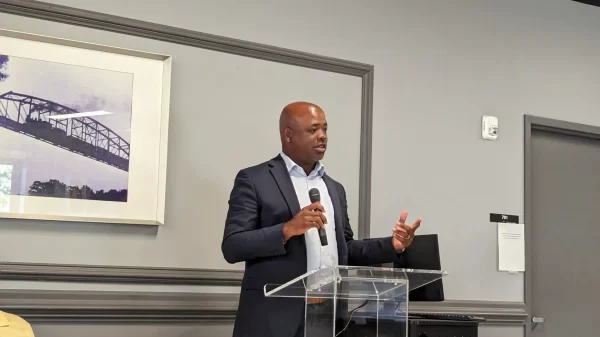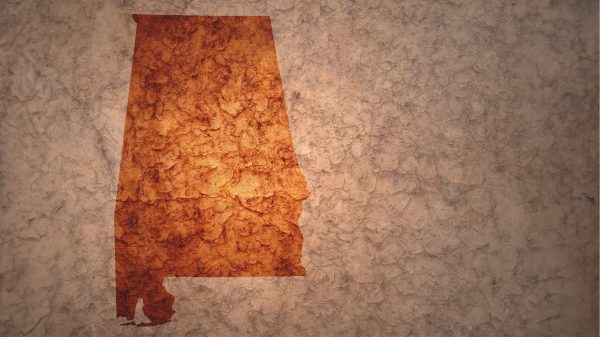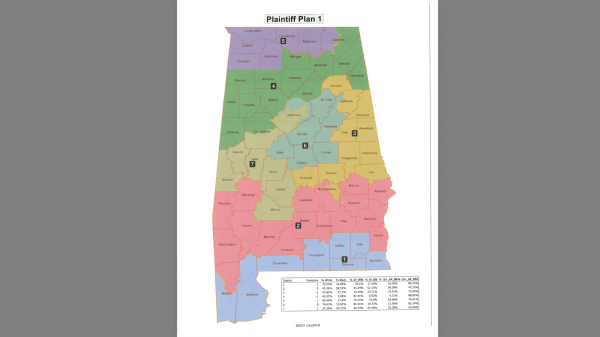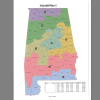By Bill Britt
Alabama Political Reporter
MONTGOMERY—On a gray Friday morning Senator Bobby Singleton, (D-Greensboro), announced from the Statehouse steps, “We have come hear today to put the state of Alabama on notice….” The notice that Senator Singleton was referring to was a lawsuit filed on behalf of the legislative black caucus and individual African American commissioners from around the state challenging reapportionment.
The lawsuit alleges that Republican lawmakers packed black voters into 27 House districts and eight Senate districts. The redistricting plans “purposely perpetuate and attempt to restore Alabama’s historical policy of segregating African Americans in party politics,” the lawsuit alleges.
The complaint filed alleges that the reapportionment plans are unconstitutional due to unnecessary violations of the whole county provision in the Alabama Constitution and the blatant racial gerrymandering of districts.
Caucus co-chairman Sen. Bobby Singleton, D-Greensboro, pointed to the plan’s use of a narrow 1 percent population deviation among the number of voters in each district instead of the 5 percent that had been used in past plans by Democrats.
Attorney James Blacksher who represents the plaintiffs says that they are challenging the district lines in part based on Section 2 of the Voting Rights Act.
The federal Voting Rights Act of 1965 was designed to combat tactics denying minorities the right to an effective vote.
The U.S. Constitution requires that each federal district have about the same population within a state. Each state district within a state must have about the same number of people, and each local district within its jurisdiction must have about the same number of people.
State and local legislative districts have more flexibility and only have to be “substantially” equal. “Over a series of cases, it has become accepted that a plan will be constitutionally suspect if the largest and smallest districts are more than ten percent apart. This is not a hard line: A state plan may be upheld if there is a compelling reason for a larger disparity, and a state plan may be struck down if a smaller disparity is not justified by a good reason,” according to summaries by the Loyola Law School, Los Angeles, CA.
In the past Alabama has used a 5 percent deviation but when drawing the new districts the Republicans used the more narrow, one percent.
“The federal courts have never approved a one percent deviation on drawing district lines in Alabama,” said Singleton.
In comparison, Colorado, for example, allows at most five percent total deviation between the largest and smallest districts; Montana’s commission has set guidelines for itself aiming for no more than six percent total deviation (each district must be at most 3 percent larger or 3 percent smaller than the “ideal”). Iowa not only also limits its total population deviation to five percent, but also sets the average deviation at no more than one percent from the “ideal,” according to the Loyola study.
The courts have relied on three threshold conditions in finding that districts need to be redrawn because Section 2 has been violated. According to the Loyola study, (These are often called Gingles conditions, after the Supreme Court’s Thornburg v. Gingles case.) The first asks whether it is possible to draw a district so that a majority of voters belong to a geographically “compact” racial, ethnic, or language minority community.
The second Gingles condition tests whether the minority population usually votes as a bloc, for the same type of candidate. This is a nuanced test: not whether the community usually votes for Democrats or Republicans (or others), but whether they would, given a fair mix of candidates, vote for the same type of Democrats or Republicans (or others).
The third Gingles condition tests the potential competition: whether the rest of the population in the area usually votes as a bloc for different candidates than those preferred by the minority community. If so, this would mean that the minority’s preferred candidate would almost always lose — if the minority community’s voting power were not specifically protected. Together, the second and third conditions are known generally as “racially polarized” voting.
Blacksher says, “plus or minus one percent makes it easier to pack black districts dilute black influence. If Blacksher accretion was found true by the federal courts then Alabama would be forced to redraw the new maps.
The argument that the GOP legislators had packed districts to dilute African-American drew terse ire from Albert Turner Jr., “When we were brought to this county we were pack in the holds of a ship we are determined that we will not be denied our rights by being packed into districts.”
Turner, is the President of Association of Black County Officials and also a Perry County Commissioner.
His father Albert Turner, Sr., helped lead the voting rights march from Selma to Montgomery, on March 7, 1965 and lead the mule wagon that carried the body of slain civil rights leader Dr. Martin Luther King, Jr., at his funeral.
The caucus and Black county officials are also sighting the violation of the Alabama State Constitution as a part of the challenge to reapportionment,
“It is critical that we challenge the constitutionality of the reapportionment plans passed by the Republican supermajority in court,” said Caucus Co-Chairman, Rep. A.J. McCampbell (D-Gallion). “The Republicans drafted these unjust plans with the goal to minimize black voting strength and isolate legislators chosen by African Americans from influence in the Alabama Legislature.”
The complaint filed alleges that the reapportionment plans are unconstitutional due to unnecessary violations of the whole county provision in the Alabama Constitution and the blatant racial gerrymandering of districts.
Under the Alabama Reapportionment Committee Guidelines for Legislative and Congressional Redistricting states, “Counties should be used as district building blocks where possible, and to the extent consistent with other aspects of these criteria. Where county lines cannot be maintained, district boundaries should follow as closely as practicable the local voting precinct boundary lines in order to minimize voter confusion and cost of election administration.
Blacksher claims the maps were partisan gerrymandering. He said they understand that Republicans, who defeated Democrats in the November 2010 election to claim the majority for the first time in 137 years.
“We hope that the federal court will recognize that the plans which the Republicans passed aimed to pack and stack African-American voters into minority districts while drastically reducing minority influence in other districts,” said Rep. John Knight, D-Montgomery.






















































